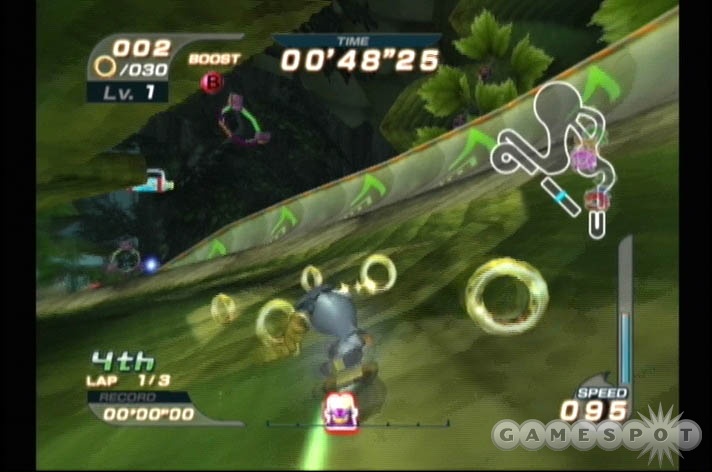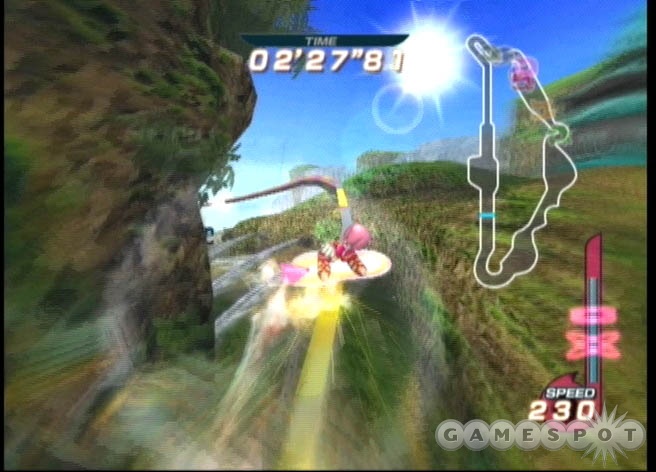Sonic Riders Hands-On
What happens when the world's fastest hedgehog gets outrun by a hoverboard? Well, if you can't beat 'em...
Sonic the Hedgehog is one of the oldest non-Nintendo game mascots still kicking, having been created way back in 1990 for the Genesis. Over the years, he and his cast of teammates have starred in a number of different types of games, including side-scrollers, fighting games, party games, and even a pinball game. In Sonic Riders, the blue-haired hedgehog tackles a multitude of gameplay styles including snowboarding, skateboarding, and racing.

You'll be forgiven if you need to read through that again: Sonic Riders definitely sports a pretty bizarre mixture of influences. Overall, the game plays as something of a mixture between an SSX-style snowboarding game--complete with jumping tricks and railgrinds--and a Hydro Thunder-esque arcade racer. It's certainly a unique experience and is looking like it might be worth checking out, if you're into arcade-style racing games. We had a chance to sit down with a build of the game recently and took away these impressions.
The plot of the game begins with Sonic, Tails, and Knuckles hanging around in Metal City, where they witness a chaos emerald being stolen by a mysterious trio of thieves known only as the Babylon Rogues. To retrieve the emerald, Sonic and company agree to go head-to-head with the Babylon Rogues in the Ex World Grand Prix, a racing tournament set up by none other than Dr. Eggman. For what it's worth, the game does a good job of integrating the plot into the heroes mode, which intersperses cutscenes between the races and sets up the rivalries between the two trios of characters.
As far as the racing goes, there are many aspects of Sonic Riders that set it apart from the pack, not the least of these being the inclusion of different classes for the characters. Each character is assigned to one of three categories: speed, air, or power. Racers of different categories will experience the race and interact with the course in fundamentally different ways. Speed characters, such as Sonic, are capable of jumping their airboard onto rails and grinding for an extra speed boost, while air characters, like Tails, can jump into accelerators suspended in midair to propel forward. Power characters don't get any special movement powers, but can instead knock aside obstacles that would normally trip up other characters, and they can even knock through weak sections of the walls to reveal shortcuts.

One of the interesting aspects about this system is that you'll really have to know the various courses in order to take advantage of the movement system that's available to your character; it's very difficult to hit all of the accelerators, rails, or shortcuts that are available to your character on your first trip around a track (though there are signs for each kind of shortcut scattered around the track, pointing out their presence). When you learn their positions, though, you'll be able to take better advantage of them; but even if you know where all the spots are, it's still tricky to use them. For instance, when grinding a rail, you can't just sit on a single rail and grind your way through; you often have to jump between numerous smaller rails. The same goes for airborne accelerators--you have to maneuver through multiple accelerators to complete your speed boost. Failing to complete an entire set of rails or accelerators will send you plummeting back to the track, or on some levels, dropping off into empty space, which will reset your position and cause you to lose a lot of time.
The reason you want to take a chance on these risky maneuvers is that they'll add to your air tank. Your air tank in Sonic Riders is somewhat like the boost meter in a game like SSX--you can use it to go faster when needed, or even attack your opponents, but it will run down when you attempt to speed up or make a sharp corner. You'll be forced to constantly recharge it, either by performing your maneuvers or by jumping into one of the air pits that are scattered around the tracks (which gradually fill up your tank at the cost of keeping you immobilized).
You can also increase your air tank by attempting to perform tricks during jumps. When you approach a jump, you have to hold down your jump button while approaching it. As is standard, the longer you hold the button down, the higher you'll eventually jump, but if you hold it down too long, your speed will be sapped. If you jump with the right timing, you'll rocket into the air and have a chance to perform your tricks. Tricking out isn't as complicated as it might seem, since everything is controlled by pressing directions on the left analog stick. The more tricks you pull off during a jump, the bigger the charge you'll receive to your air tank when you land. You're also ranked on the strength of your landing, so if you happen to try too many tricks, you'll hit the ground awkwardly and take a big speed penalty.

Lastly, one of the cooler aspects of Sonic Riders is the inclusion of turbulence. When a character starts to move especially fast, he or she will leave a tunnel of turbulence behind. If other characters hop into the tunnel (which acts essentially like a long halfpipe), they'll be able to ride inside the turbulence instead of on the track itself. There are some huge advantages to riding inside turbulence, such as the fact that it's much easier to make sharp turns while you're in the pipe. You also get a fairly large speed boost, allowing you to eventually catch up to and overtake the character that started the turbulence. If you're skillful, you can even jump up out of turbulence, do a few tricks, then land back inside the air trail to gain an even greater speed boost.
One of the high points of Sonic Riders at this point is the graphics. Everything looks very sharp, with a bright color palette and a good sense of speed, especially when you're sliding through a turbulence pipe. The drawbacks include a limited number of tracks (only five are initially selectable, although we're hoping more are unlockable) and that there's apparently no way to turn off the somewhat grating announcer's voice.
Sonic Riders is currently on point for release in late February, so check back with GameSpot for a full review when it hits store shelves.
Got a news tip or want to contact us directly? Email news@gamespot.com
Join the conversation